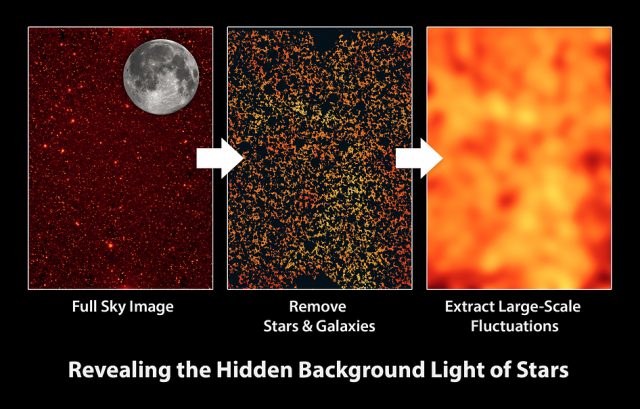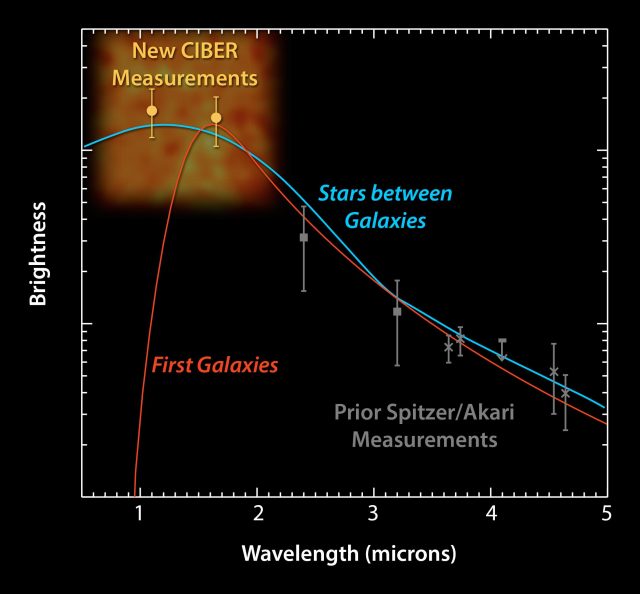The light that remains: the cosmic infrared background unveiled
Let’s start with a thought experiment. We are looking up to a starry night sky. What if we turn off every star in our Galaxy? The heavens would become much darker, but some light sources would still be working. The Moon and planets? Great, let’s turn them off too. Yet another Solar System phenomenon would be active: zodiacal light. Unless we had also previously included the Sun in our selective blackout, we may see its light illuminating the interplanetary dust. Let’s remove it. Anything else? Near galaxies, off. Higher redshift galaxies from the young universe, off. Echoes from the primordial Big Bang, off. The sky should be pretty dark by now but, still, it would not be completely black. If we were sensitive enough, we would be able to detect a faint cosmic background that, particularly at near infrared wavelengths, unevenly lightens the skies. This radiation from unresolved and unknown sources is what we call the cosmic infrared background (CIB).

The study of this radiation is precisely one of the main goals of the Cosmic Infrared Background ExpeRiment (CIBER), a sounding rocket experiment which has flight four times since 2010. This facility is the result of the collaboration of some universities and laboratories from USA, Japan and South Korea. Since it is focused on unresolved sources, the objective is to study the spatial distribution of the background and, given that the near infrared photons are thought to be a product of the stellar nucleosynthesis, therefore “constrain the stellar content of the Universe”.
The study of the anisotropies in the CIB is able to probe emissions from galaxies at the epoch of reionization and from the intrahalo light (IHL) coming from stars expelled from their parent galaxies due to tidal interactions in the near universe. In a 2012 paper, Asantha Cooray and colaborators 1 showed that neither the young distant galaxies nor the intermediate dwarf galaxies were able to explain the anisotropies detected at arcminute to degree scales, therefore requiring the intrahalo stars. This proved that a study at wavelengths around 1 μm for these spatial scales would be a substantial step further in our understanding of the problem. But still, most of the instruments before CIBER had two big fields of view to be sensitive to the appropriate spatial scales.

Using data from Spitzer and two of the four CIBER flights, Michael Zemcov and collaborators 2 have just published a paper in Science showing that the observed anisotropies at those wavelengths and spatial scales require the IHL to be explained. Depending on the spectral properties of the stellar population responsible for this radiation, a significant fraction of the existing stars could be found outside but around the galaxies as we currently understand them. The spectrum is bluer than it would be expected for first galaxies and dominates at the arcminute scale. This may have a direct impact in two enigmas of the current Astrophysics.

The first one is the photon underproduction crisis, raised by Juna Kollmeier et al. earlier this year3. The basic idea is that the statistics of Lyman-α showed the need of having a metagalactic source of photoionization some five times greater than previously expected in the near universe at low redshifts. The Lyman-α forest is the set of absorption features progressively redshifted following an emission in the distant universe, at high redshifts. This is one of the best tools for the astrophysicists to probe the intergalactic medium by using the light coming from the youngest galaxies. The paper by Kollmeier et al. pointed out that their analysis requires a change in the way we understand either the far or the near universe in order to account for these lost photons. The work by Zemcov could help solving this disagreement.
An older, best known problem is the uncertain cosmic baryon budget, as for example discussed by Fukugita et al. in 1998 4. We do know by other means how many baryons should be in the universe in order to account for the determined cosmological constants. Estimations vary but less than 20% might be in the form of stars and stellar systems. Most of the baryonic matter would be in the form of gas, in particular coronal gas and most of this is invisible at low redshifts, so we cannot trace where are those missing baryons in our space-time surroundings. What if some of them form new stars we have no been previously aware of? This is the idea behind the halo stars proposed by Zemcov and might be a substantial contribution to the current baryon budget.
The light that remains when you eliminate most sources of radiation in the sky becomes therefore a good piece in our cosmological puzzle. Even if we are not able to resolve these sources separately, the ingenuity of the researchers provides considerable information on how this matter is distributed. Although there is still quite a lot of work to be done, these results are both and observational and theoretical challenge for the Astrophysics. And that’s a lot of fun, isn’t it?
References
- A. Cooray et al. (2012). Near-infrared background anisotropies from diffuse intrahalo light of galaxies. Nature 490, 514. doi: 10.1038/nature11474 ↩
- Zemcov M., T. Arai, J. Bock, A. Cooray, Y. Gong, M. G. Kim, P. Korngut, A. Lam, D. H. Lee & T. Matsumoto & (2014). On the origin of near-infrared extragalactic background light anisotropy, Science, 346 (6210) 732-735. DOI: http://dx.doi.org/10.1126/science.1258168 ↩
- J.A. Kollmeier et al. (2014). The photon underproduction crisis. The Astrophysical Journal Letters 789, L32. doi: 10.1088/2041-8205/789/2/L32 ↩
- M. Fukugita et al. (1998). The cosmic baryon budget. The Astrophysical Journal 503, 518. arxiv: astro-ph/9712020v2 ↩
3 comments
[…] Imajinatu Eguzkia itzaltzen duzula, eta berarekin batera planetetatik eta beraien sateliteetatik, asteroideetatik eta kometetatik datorren argia ere itzaltzen dela. Hala ere, gure zerua ez da guztiz ilun egongo. Beraz, amatatu ditzagun izarrak eta galaxiak eta, baita ere inflazio kosmikoko […]
[…] Imagínate que apagas el Sol y con él la luz que nos llega de los planetas y sus satélites, de los asteroides, de los cometas, de la luz zodiacal. Sin embargo nuestro cielo no estaría oscuro todavía: apaguemos estrellas […]
[…] [Leer la entrada completa en Mapping Ignorance] Tweet […]